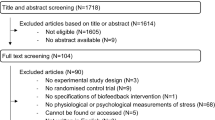Abstract
Six insulin-treated diabetic patients (four with type I and two with type II) who completed a biofeedback-assisted stress management program based on family systems theory improved their response to life stressors, and none had negative side effects. Four decreased their insulin requirement, including one who remained stable even during two pregnancies; the sixth became stable and discontinued drug abuse. All started biofeedback for reasons other than diabetes. Follow-ups of some individuals extend over 4 years.
Similar content being viewed by others
References
Anderson B. J., & Auslander, W. F. (1980). Research on diabetes management and the family: A critique.Diabetes Care 3(6), 696–702.
Bowen, M. (1978).Family therapy in clinical practice. New York: Jason Aronson.
Bradley, F. (1982). Psychophysiological aspects of the management of diabetes mellitus.International Journal of Mental Health, 11(3), 117–132.
Budzynski, T. H. (1975). Systems approach to biofeedback training. Audiocassette and Flow Chart T-18. New York: Bio-Monitoring Applications.
Daniels, G. E. (1939). Present trends in the evaluation of psychic factors in diabetes mellitus.Psychosomatic Medicine, 1(1), 527–552.
Dunn, S. M., & Turtle, J. R. (1981). The myth of the diabetic personality.Diabetes Care, 4(6), 640–646.
Eaton, R. P., & Schade, D. S. (1980). Stress hormones and metabolic decompensation in man. In W. K. Waldhausl, (Ed.),Diabetes 1979. Proceedings of the 10th Congress of the International Diabetes Foundation, Vienna, Austria, September 9–14, 1979 (pp. 700–703). Princeton: Excerpta Medica.
Ellenberg, M., & Rifkin, H. (1970).Diabetes mellitus (pp. 920–933). New York: McGraw Hill.
Fowler, J. E., Budzynski, T., & Vandenbergh, R. (1976). Effects of an EMG biofeedback relaxation program on the control of diabetes: A case study.Biofeedback and Self-Regulation, 1, 105–112.
Gerich, J. E., & Lorenzi, M. (1978). The role of the autonomic nervous system and somatostatin in the control of insulin and glucagon secretion. In W. R. Ganong & L. Martini, (Eds.),Frontiers in neuroendocrinology (Vol. 5, pp. 265–288). New York: Raven Press.
Hauser, S. T., & Pollets, D. (1979). Psychological aspects of diabetes mellitus: A critical review.Diabetes Care, 2(2), 227–232.
Jacobson, E. (1968).Progressive relaxation (2nd ed.), Chicago: University of Chicago Press.
Johnson, S. B. (1980). Psychosocial factors in juvenile diabetes: A review.Journal of Behavioral Medicine, 3 95–113.
Lipsett, L. (1982, March 4).Diabetes mellitus in an overview. Paper presented at the Third Annual Meeting of the Society of Behavioral Medicine, Chicago.
Luthe, W. (Ed.), (1969).Autogenic therapy: Vol. 2. Medican applications (pp. 107–113). New York: Grune and Stratton.
Michigan Diabetes Research and Training Center. (1980). Patient education materials. Ann Arbor: University of Michigan.
National Diabetes Information Clearinghouse Bulletin, The.Diabetes dateline, 1980-present.
Peterson, C. M., et al. (1979). Feasibility of improved blood glucose control in patients with insulin dependent diabetes mellitus.Diabetes Care, 2(4), 329–335.
Pohl, S. (1982, March 5). Physiology of diabetes and its complications. Short Course, Society of Behavioral Medicine, Third Annual Meeting, Chicago.
Rosenbaum, L. (1981). Biofeedback assisted relaxation in diabetes management. Proceedings of the Twelfth Meeting of the Biofeedback Society of America: The Integration of Biofeedback With Other Therapies (pp. 64–66). Louisville, Kentucky.
Rosenbaum, L., Greco, P., Sternberg, C., & Singleton, G. (1981). Ongoing assessment: Experience of a university biofeedback clinic.Biofeedback and Self-Regulation, 6 103–112.
Salans, L. B. (1982). Diabetes mellitus: A disease that is coming into focus.Journal of the American Medical Association, 247(5), 590–594.
Seeburg, K. N., & DeBoer, K. F. (1980). Effects of EMG biofeedback on diabetes.Biofeedback and Self-Regulation, 5 289–293.
Shuman, C. R. (1980). Self-monitoring of blood glucose by the diabetic patient.Practical Cardiology, 6(7).
Steiner, S. S. & Dinle, W. M. (1981). Biofeedback efficacy studies: A critique of critiques.Biofeedback and Self-Regulation, 6 275–288.
Sterling, P., & Eyer, J. (1981). Biological basis of stress related mortality.Social Science Medicine, 15E 3–42.
Stroebel, C. F. (1978).Quieting response training. Audiocassette # MV8. New York: Bio-Monitoring Applications.
Surwit, R. S., Feinglos, M. N., & Scovern, A. W. (1983). Diabetes and behavior: A paradigm for health psychology.American Psychologist, 38(3), 255–262.
Thorn, G. W., Adams, R. D., Braunwald, E., Isselbacher, K. J., & Petersdorf, R. G. (1977).Harrison's principles of internal medicine (8th ed). New York: McGraw-Hill.
Treuting, T. (1962). The role of emotional factors in the etiology and course of diabetes mellitus: A review of the recent literature.American Journal of Medical Sciences, 244(July), 93–109.
Willis, T. (1684).Practice of physik: Treatise II, pharmaceutic rationalis. London: Dring, Hayes, and Leight.
Wolpe, J. (1973). The practice of behavior therapy (2nd ed). New York: Pergamon Press.
Author information
Authors and Affiliations
Additional information
Appreciation for their ideas and work goes to Priscilla Friesen, A.C.S.W., Georgetown University Family Center; Elaine Trogdon, Medical College of Virginia 84'; Grace Cordts, M.S., M.P.H., University of Maryland '85; and Mindy Bassin, Northwestern University Medical School, '85; to Bernard Brown, Ph.D., for data interpretation; to Robert Tanenberg, M.D., editorial consultant; and to the diabetics from whom I learned.
Rights and permissions
About this article
Cite this article
Rosenbaum, L. Biofeedback-assisted stress management for insulin-treated diabetes mellitus. Biofeedback and Self-Regulation 8, 519–532 (1983). https://doi.org/10.1007/BF00998759
Issue Date:
DOI: https://doi.org/10.1007/BF00998759




